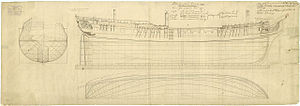
| |
| History | |
|---|---|
| Name | HMS Triton |
| Ordered | 25 December 1770 |
| Builder | Henry Adams, Bucklers Hard |
| Laid down | February 1771 |
| Launched | 1 October 1773 |
| Completed | 4 November 1775 at Portsmouth Dockyard |
| Commissioned | August 1775 |
| Fate | Taken to pieces at Deptford in January 1796 |
| General characteristics | |
| Class and type | Modified Mermaid-class frigate |
| Tons burthen | 620 21⁄94 (bm) |
| Length |
|
| Beam | 33 ft 7 in (10.24 m) |
| Sail plan | Full-rigged ship |
| Complement | 200 officers and men |
| Armament |
|
HMS Triton was a modified Mermaid-class sixth-rate 28-gun frigate of the Royal Navy. She was ordered on 25 December during the Falklands Crisis of 1770, a conflict that was resolved the following January, before work on her had begun. Launched in October 1773, she first served in the American Revolutionary War in operations against the rebels on the St Lawrence River. In 1780, she sailed with Rear admiral George Rodney's fleet for the Relief of Gibraltar and on 8 January, assisted in an attack on a Caracas Convoy off the coast of Spain, capturing several Spanish merchant ships. Later that month she played a role at the Battle of Cape St Vincent. During the French Revolutionary Wars Triton served on the Jamaica Station and was present at the Battle of the Saintes on 12 April 1782. She finally paid off in November 1795 and was broken up at Deptford Dockyard in January 1796.